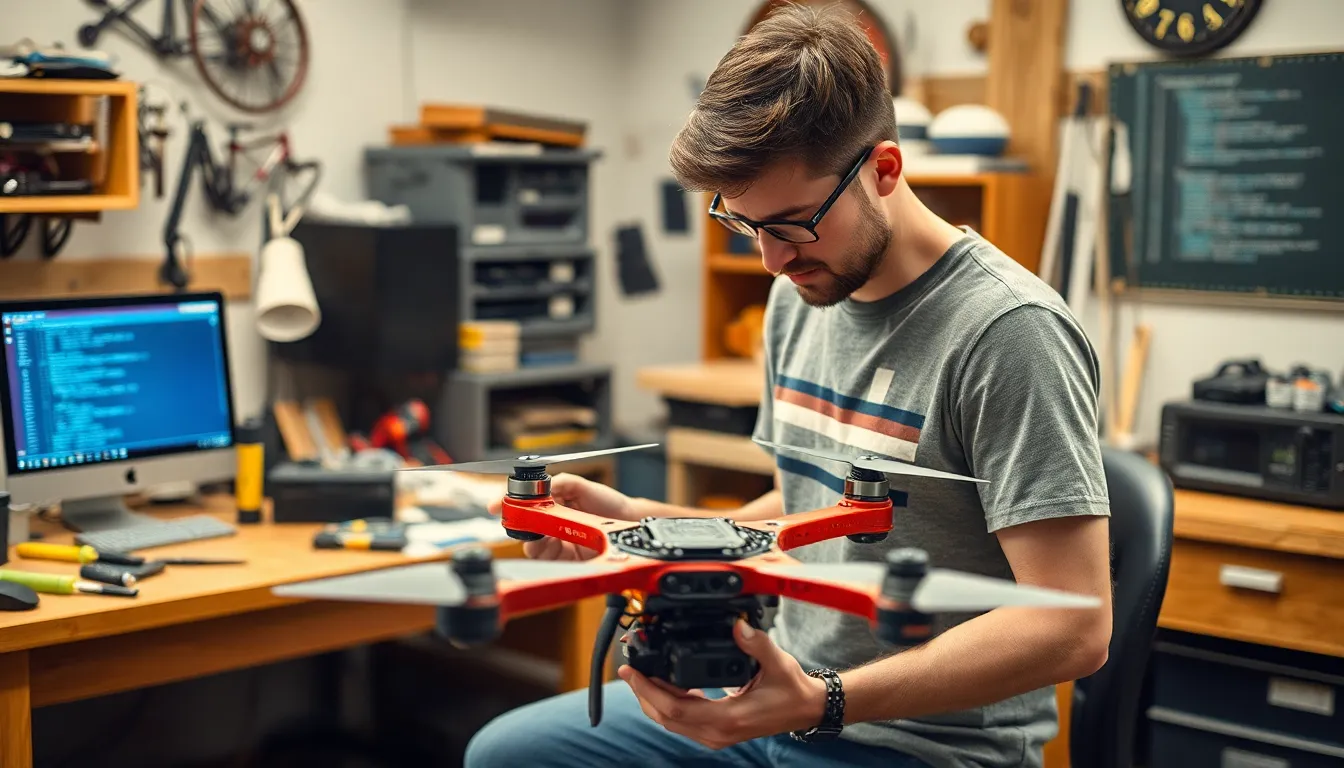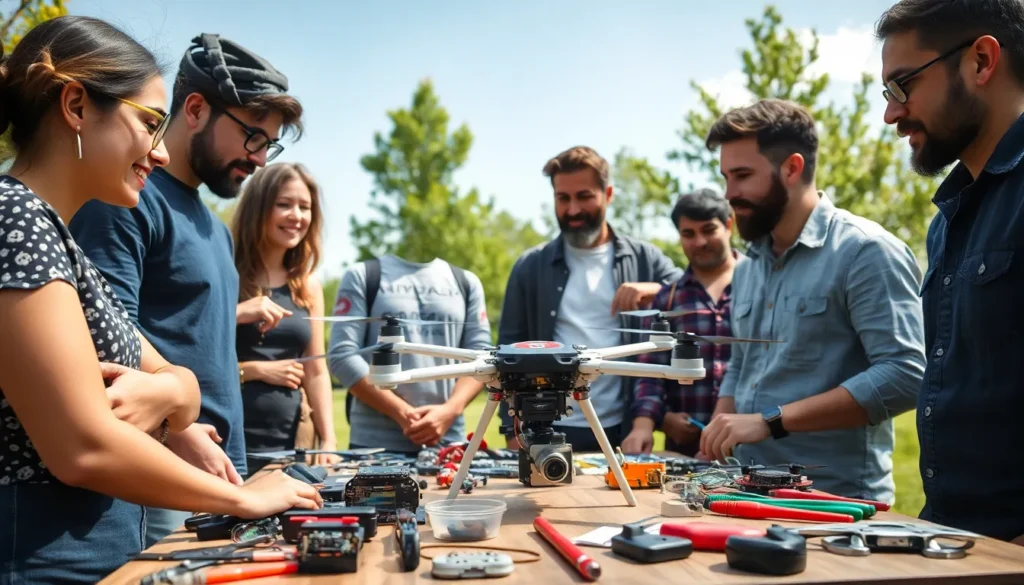In a world where drones are buzzing around like over-caffeinated bees, open-source drones are the quirky rebels shaking things up. Imagine a flying machine that not only captures breathtaking aerial footage but also lets you tinker with its code like a kid in a candy store. These drones invite enthusiasts and innovators alike to join the fun, creating a vibrant community that thrives on collaboration and creativity.
Table of Contents
ToggleOverview of Open-Source Drones
Open-source drones have gained significant traction in recent years due to their flexibility and accessibility. These flying machines use shared knowledge to enable modifications and improvements, which attracts hobbyists and professionals alike. Enthusiasts access design files, software codes, and community forums to collaborate and innovate.
The transparency in the designs encourages creativity. Users can experiment with various configurations to enhance performance or add new functionalities. Community-driven projects often lead to advancements in technology, as contributors share solutions and ideas.
Multiple platforms exist where users can find open-source drone models. Examples like ArduPilot and PX4 provide frameworks for building and customizing drones. These platforms contain extensive documentation, making it easy for new users to get started.
Cost efficiency plays an essential role in the popularity of open-source drones. Users can source components and build drones tailored to their specific needs without the financial burden associated with commercial models. This democratization of technology fosters an inclusive environment for learning and experimentation.
Safety regulations and guidelines also influence the development of open-source drones. Many communities prioritize responsible flying practices, ensuring that users adhere to local regulations. By sharing best practices, enthusiasts contribute to a safer experience for all users.
Through collaboration, innovation, and affordability, open-source drones continue to shape the future of the industry. Their appeal lies not only in the ability to create unique designs but also in building a strong community of like-minded individuals.
Benefits of Open-Source Drones

Open-source drones provide numerous advantages that appeal to both enthusiasts and professionals. Their unique characteristics foster a community centered around collaboration and creativity.
Cost-Effectiveness
Cost-effectiveness stands out among the primary benefits of open-source drones. Users save significantly by building customized drones instead of purchasing expensive commercial alternatives. With the availability of open-source design files and software codes, developers can use affordable components to create high-functioning devices. Many hobbyists find that they can assemble a fully functional drone for a fraction of the price of proprietary models. Financial accessibility enables a wider audience to engage with technology while acquiring essential skills in engineering and programming. Thus, affordability plays a vital role in attracting a diverse range of users into the world of drones.
Customization and Flexibility
Customization and flexibility define the heart of open-source drones. Users can alter designs and software to meet specific needs, allowing for unique configurations based on individual preferences. Each project can incorporate specific components like cameras, sensors, or propulsion systems. Moreover, users can adapt their drones for various applications such as aerial photography, agricultural monitoring, or mapping. This flexibility encourages innovation and experimentation, giving creators the freedom to test new ideas and push technical boundaries. Access to extensive documentation and community support further enhances the potential for customization, ensuring that each user can craft a drone tailored to their requirements.
Popular Open-Source Drone Projects
Open-source drones continue to thrive within a variety of projects. Two prominent platforms in this space are PX4 and ArduPilot.
PX4
PX4 stands out as a leading open-source flight control software platform. It supports a wide range of vehicles, including multirotors, fixed-wing aircraft, and VTOL drones. Extensive documentation accompanies PX4, making it user-friendly for both beginners and experts. The software provides robust features such as automatic mission planning and real-time telemetry. Additionally, PX4 fosters a vibrant community contributing to ongoing development and support. Users find that its modular architecture enhances adaptability, allowing for specific customizations based on individual requirements. The combination of flexibility and extensive community support establishes PX4 as a top choice for drone enthusiasts and developers.
ArduPilot
ArduPilot serves as another essential project within the open-source drone ecosystem. Known for its versatility, it caters to a variety of vehicle types, including airplanes, copters, and rovers. ArduPilot offers rich documentation and active community forums, helping users navigate challenges effectively. The platform includes features like waypoint navigation, automated landings, and telemetry data analysis. Customization plays a key role, enabling users to tailor vehicle configurations to meet distinct needs. Its reliable performance under various conditions further solidifies ArduPilot’s status. Enthusiasts and professionals alike benefit from ArduPilot’s comprehensive capabilities, fostering innovation and creativity in drone applications.
Applications of Open-Source Drones
Open-source drones serve various practical applications across multiple sectors, demonstrating their versatility and effectiveness.
Research and Development
Research and development benefit significantly from open-source drones. Scientists frequently utilize modified drones for data collection in areas like climate research and wildlife observation. Real-time data from these drones often provides insights that drive further innovations. Additionally, collaboration among researchers fosters a dynamic exchange of ideas and solutions. Educational institutions leverage open-source platforms to teach students about aerospace engineering and robotics. Students gain hands-on experience by participating in drone design and programming tasks. Research teams easily adapt their drones for specific experiments, enhancing their capabilities and outcomes.
Agriculture and Environmental Monitoring
Agriculture and environmental monitoring frequently leverage open-source drones for precision tasks. Farmers utilize these drones to assess crop health, optimize irrigation, and monitor soil conditions. Data collected aids in making informed decisions that enhance yield and reduce waste. Environmental organizations utilize drones for mapping ecosystems and monitoring wildlife populations. Open-source platforms allow users to tailor drones for specific environmental assessments, ensuring accuracy and efficiency. Various community projects utilize drones to track deforestation and assess pollution levels. These applications illustrate the transformative potential of open-source drones in both agriculture and environmental conservation.
Challenges and Limitations
Open-source drones face a range of challenges and limitations that can impact their development and usage. Understanding these obstacles helps users navigate the complex landscape of drone technology.
Technical Expertise Required
Users encounter a steep learning curve when working with open-source drones. Developing and modifying code demands solid programming skills and familiarity with flight control software. Knowledge in electronics and mechanical design enhances their ability to customize drones effectively. Many enthusiasts may find the initial hurdles daunting. Community forums, documentation, and tutorials often serve as valuable resources, providing guidance on best practices and troubleshooting. Users build crucial skills through hands-on experience, but without foundational knowledge, unlocking the full potential of open-source drones becomes difficult.
Regulatory Hurdles
Regulatory frameworks represent significant challenges facing open-source drone users. Compliance with local aviation authorities is essential for responsible operation. Many regions enforce strict laws addressing drone registration, flight zones, and safety standards. Navigating these regulations requires diligence and ongoing awareness of legislative changes. Violating these rules can result in fines or restrictions, which may deter potential users. Developing an understanding of these regulations begins when users engage with local communities and forums that share up-to-date information. Awareness and compliance enhance safety and promote a culture of responsible drone usage.
Open-source drones are revolutionizing the way enthusiasts and professionals approach aerial technology. Their customizable nature not only empowers users to innovate but also fosters a thriving community dedicated to collaboration and shared knowledge. By making drone technology more accessible and affordable, these platforms are paving the way for diverse applications across various sectors.
Despite the challenges of learning and regulatory compliance, the benefits of open-source drones far outweigh the obstacles. As users continue to explore their potential, the future of this technology looks promising. With ongoing support from vibrant communities and resources, open-source drones will undoubtedly play a crucial role in shaping advancements in engineering, environmental monitoring, and beyond.

